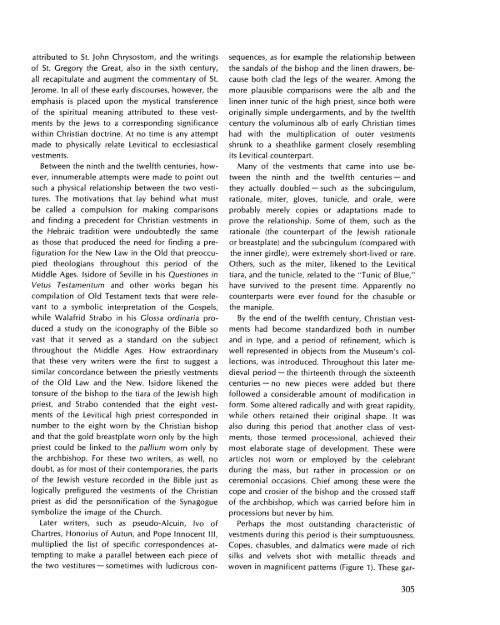The Metropolitan Museum of Art Bulletin, v. 29, no. 7 (March, 1971)
The Metropolitan Museum of Art Bulletin, v. 29, no. 7 (March, 1971)
The Metropolitan Museum of Art Bulletin, v. 29, no. 7 (March, 1971)
Create successful ePaper yourself
Turn your PDF publications into a flip-book with our unique Google optimized e-Paper software.
attributed to St. John Chrysostom, and the writings<br />
<strong>of</strong> St. Gregory the Great, also in the sixth century,<br />
all recapitulate and augment the commentary <strong>of</strong> St.<br />
Jerome. In all <strong>of</strong> these early discourses, however, the<br />
emphasis is placed upon the mystical transference<br />
<strong>of</strong> the spiritual meaning attributed to these vestments<br />
by the Jews to a corresponding significance<br />
within Christian doctrine. At <strong>no</strong> time is any attempt<br />
made to physically relate Levitical to ecclesiastical<br />
vestments.<br />
Between the ninth and the twelfth centuries, however,<br />
innumerable attempts were made to point out<br />
such a physical relationship between the two vestitures.<br />
<strong>The</strong> motivations that lay behind what must<br />
be called a compulsion for making comparisons<br />
and finding a precedent for Christian vestments in<br />
the Hebraic tradition were undoubtedly the same<br />
as those that produced the need for finding a prefiguration<br />
for the New Law in the Old that preoccupied<br />
theologians throughout this period <strong>of</strong> the<br />
Middle Ages. Isidore <strong>of</strong> Seville in his Questiones in<br />
Vetus Testamentum and other works began his<br />
compilation <strong>of</strong> Old Testament texts that were relevant<br />
to a symbolic interpretation <strong>of</strong> the Gospels,<br />
while Walafrid Strabo in his Glossa ordinaria produced<br />
a study on the ico<strong>no</strong>graphy <strong>of</strong> the Bible so<br />
vast that it served as a standard on the subject<br />
throughout the Middle Ages. How extraordinary<br />
that these very writers were the first to suggest a<br />
similar concordance between the priestly vestments<br />
<strong>of</strong> the Old Law and the New. Isidore likened the<br />
tonsure <strong>of</strong> the bishop to the tiara <strong>of</strong> the Jewish high<br />
priest, and Strabo contended that the eight vestments<br />
<strong>of</strong> the Levitical high priest corresponded in<br />
number to the eight worn by the Christian bishop<br />
and that the gold breastplate worn only by the high<br />
priest could be linked to the pallium worn only by<br />
the archbishop. For these two writers, as well, <strong>no</strong><br />
doubt, as for most <strong>of</strong> their contemporaries, the parts<br />
<strong>of</strong> the Jewish vesture recorded in the Bible just as<br />
logically prefigured the vestments <strong>of</strong> the Christian<br />
priest as did the personification <strong>of</strong> the Synagogue<br />
symbolize the image <strong>of</strong> the Church.<br />
Later writers, such as pseudo-Alcuin, Ivo <strong>of</strong><br />
Chartres, Ho<strong>no</strong>rius <strong>of</strong> Autun, and Pope In<strong>no</strong>cent III,<br />
multiplied the list <strong>of</strong> specific correspondences attempting<br />
to make a parallel between each piece <strong>of</strong><br />
the two vestitures -sometimes with ludicrous con-<br />
sequences, as for example the relationship between<br />
the sandals <strong>of</strong> the bishop and the linen drawers, because<br />
both clad the legs <strong>of</strong> the wearer. Among the<br />
more plausible comparisons were the alb and the<br />
linen inner tunic <strong>of</strong> the high priest, since both were<br />
originally simple undergarments, and by the twelfth<br />
century the volumi<strong>no</strong>us alb <strong>of</strong> early Christian times<br />
had with the multiplication <strong>of</strong> outer vestments<br />
shrunk to a sheathlike garment closely resembling<br />
its Levitical counterpart.<br />
Many <strong>of</strong> the vestments that came into use between<br />
the ninth and the twelfth centuries-and<br />
they actually doubled-such as the subcingulum,<br />
rationale, miter, gloves, tunicle, and orale, were<br />
probably merely copies or adaptations made to<br />
prove the relationship. Some <strong>of</strong> them, such as the<br />
rationale (the counterpart <strong>of</strong> the Jewish rationale<br />
or breastplate) and the subcingulum (compared with<br />
the inner girdle), were extremely short-lived or rare.<br />
Others, such as the miter, likened to the Levitical<br />
tiara, and the tunicle, related to the "Tunic <strong>of</strong> Blue,"<br />
have survived to the present time. Apparently <strong>no</strong><br />
counterparts were ever found for the chasuble or<br />
the maniple.<br />
By the end <strong>of</strong> the twelfth century, Christian vestments<br />
had become standardized both in number<br />
and in type, and a period <strong>of</strong> refinement, which is<br />
well represented in objects from the <strong>Museum</strong>'s collections,<br />
was introduced. Throughout this later medieval<br />
period- the thirteenth through the sixteenth<br />
centuries-<strong>no</strong> new pieces were added but there<br />
followed a considerable amount <strong>of</strong> modification in<br />
form. Some altered radically and with great rapidity,<br />
while others retained their original shape. It was<br />
also during this period that a<strong>no</strong>ther class <strong>of</strong> vestments,<br />
those termed processional, achieved their<br />
most elaborate stage <strong>of</strong> development. <strong>The</strong>se were<br />
articles <strong>no</strong>t worn or employed by the celebrant<br />
during the mass, but rather in procession or on<br />
ceremonial occasions. Chief among these were the<br />
cope and crosier <strong>of</strong> the bishop and the crossed staff<br />
<strong>of</strong> the archbishop, which was carried before him in<br />
processions but never by him.<br />
Perhaps the most outstanding characteristic <strong>of</strong><br />
vestments during this period is their sumptuousness.<br />
Copes, chasubles, and dalmatics were made <strong>of</strong> rich<br />
silks and velvets shot with metallic threads and<br />
woven in magnificent patterns (Figure 1). <strong>The</strong>se gar-<br />
305

















